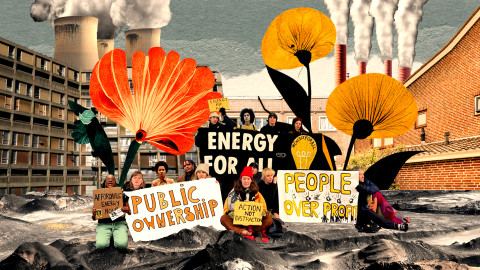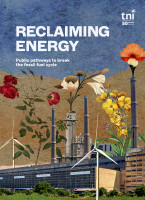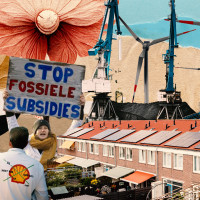The living legacy of privatisation in the United Kingdom Energy transition country struggle
Regions
In March 2022, Russia’s attack on Ukraine instigated a global energy crisis. In the UK, this compounded a domestic energy crisis which had been underway since winter 2021 – a disaster that was decades in the making and that can be traced back to Margaret Thatcher’s fateful decision to privatise the country’s energy sector in the 1980s.1

Illustration by Fourate Chahal El Rekaby
Thatcherism and its legacy
To strengthen the post-Second World War economy, fundamental industries, including electricity, railways, coal and steel, were nationalised by the Labour Government. Yet following the 1979 election of the Conservative Party, under the leadership of Margaret Thatcher, the government pursued aggressive privatisation policies. More than 40 UK state-owned businesses, employing 600,000 workers, were privatised between 1979 and 1990.5 What’s more, Thatcher’s model for energy privatisation and liberalisation became a template enforced across the world for years to come.
Arguing that privatisation would make firms more efficient and increase labour productivity, Thatcher moved to privatise the country’s energy market in the mid-1980s, in the aftermath of the global energy crisis of the 1970s.6 To transform this natural monopoly into an artificial, competitive market, the energy sector was ‘unbundled’ into the separate components of generation, transmission, distribution and supply. In 1986, the gas sector was privatised. The electricity sector followed in 1990, when twelve regional electricity companies in England and Wales were sold off to private firms. In the end, virtually all components of the energy system were placed under private ownership.
The unbundling of the energy sector in the 1980s paved the way for an oligopolistic structure in which the so-called ‘big five’ firms (British Gas, EDF Energy, E.ON UK, ScottishPower and Ovo Energy) currently control 70 per cent of the household energy market.7,8Far from the competition that privatisation advocates promised, the policy landscape surrounding these large, often foreign-owned, energy companies drives out smaller suppliers and has kept bills high. Recent attempts to establish municipal energy companies have failed, in part due to the difficulties these small firms faced in competing with huge transnational corporations, alongside the challenges of operating within a highly volatile market context.9 In recognition of the monopoly being created in the supply market, in 2013 the energy market regulator Ofgem encouraged new suppliers to enter the market to ‘increase competitive pressure on prices for the benefit of customers’.10 This did little to protect customers during the recent energy crisis.
The failures of privatisation
The results of decades of neoliberal market policies are still felt by consumers today. With gas prices soaring during the 2021 energy crisis, many households were unable to handle steep increases in energy bills. At the core of the crisis lies the UK’s dependency on imported fossil fuels, reinforced by a lack of investment in renewable energy due to higher profit prospects in the gas sector and planning laws skewed against renewables. Following the privatisation of gas in the 1980s, the famous ‘dash for gas’ fast-tracked a transition away from coal-fired power plants, while creating a dependence on newly discovered gas supplies in the North Sea. By the mid-2000s, gas production in the North Sea fell sharply, prompting the UK to import gas from Norway, the Netherlands, Belgium, Qatar, the US, and Russia. When international gas prices rose in 2021, 86 per cent of British homes were dependent on gas for heating, while more than one-third of electricity in the country was produced using gas power plants.11
The 2021 crisis also showed the government’s determination to prioritise private profit over the common good. The crisis saw dozens of smaller suppliers go out of business, costing British consumers £2.7 billion, a figure paid for via energy bills that were already soaring due to 250 per cent gas price increases.12 Meanwhile, large private energy firms on the brink of collapse were bailed out by the government to the tune of billions of pounds.13 These firms have continued to record disproportionately high profits. Due to rising oil prices, BP's profits tripled between 2021 and the second quarter of 2022, reaching nearly £7 billion.14 The UK’s big five energy suppliers made more than £1 billion in profit in 2020/2021, shortly before consumers were hit with major price increases.15 Centrica (the parent company of British Gas), for example, operates with a profit margin of 60 per cent in its generation business.16
Despite skyrocketing profits, the failure of Britain’s privatised energy sector could not be more obvious. In November 2021, news of yet another collapsed energy supplier surfaced. As private company Bulb went bankrupt it was purchased by Octopus energy, another private supplier, costing households an estimated £246 million.17 As more and more energy suppliers go out of business, it is clear that the market cannot deliver the competition and lower prices that privatisation advocates promised. At the same time, domestic energy bills are constantly on the rise: energy bills increased by 50 per cent in real terms between 1996 and 2018, leaving increasing numbers struggling to heat their homes.18
In 2022, the government approved a new coal mine, the first since Thatcher began closing them down in the 1980s. The mine, which is ultimately owned by private equity investment firm EMR Capital, would create a maximum of 500 jobs and its coal quality is poor, discrediting any claim that this project would significantly benefit the local economy or energy security. Then, in 2023, the government approved 100 new North Sea oil and gas licences.19 The UK tax rate on oil and gas is currently lower than that of many equivalent economies such as Norway. Additional changes to carbon-trading markets are now making it cheaper to pollute.20 Despite these moves from the Conservative government, in September 2024, the UK’s High Court ruled that the approval of the coal mine was unlawful and overturned the approval.21 This followed a Supreme Court ruling a few weeks earlier that planning applications for fossil fuel projects must consider the environmental impact of burning the fossil fuels, not just of extracting them, which had not happened in the case of the mine.22
In August 2024, the Offshore Petroleum Regulator, OPRED, announced a pause on processing existing and new North Sea oil and gas licences until the government issues new guidance on environmental impact assessments in 2025.23 Thus, the future of fossil fuel production in the UK is somewhat uncertain.
Over a decade of Conservative party governments have left the public dissatisfied with a privatised energy system marked by the collapse of over 30 energy suppliers since 2021. According to 2023 government data, 3 million people are living in fuel poverty.24 Meanwhile, systemic underinvestment in vital energy infrastructure has gone unchecked.
A return to public ownership?
Instead of forcing companies to deliver on their mandate, in 2022 the Conservative government announced it would bring a division of the privately owned National Grid back into public ownership to better meet net zero targets.25 In its place, a publicly owned ‘Future System Operator’ is being set up to operate energy grids from 2024 onwards.26 The new public body will be responsible for managing the planning and distribution of Britain’s electricity system to prevent supply interruptions. While renationalisation is an essential step towards the public control needed for a just energy transition, the move attests to the recognition of a wider failure of the UK’s privatised and fragmented energy sector. Private actors have failed to deliver a service yet have still been generously paid with no consequences. Moreover, without a nationwide systematic reclaiming of the entire energy system, the fragmentation within Britain's energy sector will continue to allow profiteering to push up tariffs and make the energy transition harder to realise.
Calls from trade unions and activists to take back public ownership and transition to renewable energy are getting louder, with 66 per cent of the UK population supporting nationalisation of the country’s energy system.27 The trade union UNISON is advocating for the nationalisation of the big five energy retail companies. This would mean transferring over 34,000 energy workers from private companies into public service employment, allowing the state to leverage this workforce to promote a transition to renewable energies.28 In 2019, UNISON, GMB, Unite and Prospect, the UK’s four main energy trade unions, published a list of demands to protect energy workers’ jobs in a just transition to renewable energy. These include, most importantly, greater influence for unions and workers affected by the transition, granting them a voice in policy-making and the opportunity to contribute to solutions.29
A further proposal for public ownership has been brought forward by the We Own It campaign organisation, which advocates for public services to be run for people not profit. Instead of a government bailout when supply companies collapse, they advocate for bringing supply companies into one public supplier.30 The campaign’s petition to nationalise energy outlines four further actions to reclaim public ownership:
- Nationalising the ‘big five’ energy suppliers, which would cost the state approximately £2.85 billion.
- Taxing giants BP and Shell at the same rate as Norway taxes fossil fuel companies: a permanent tax rate of 56 per cent (on top of corporation tax).
- Setting up a new state-owned renewable energy company to invest in wind- and waterpower while creating public jobs.
- Nationalising the energy grid, which would bring expected annual savings of £3.7 billion, and would pay for itself in under eight years.31
Democratic and public ownership of the energy market was a central proposal of the 2017 Labour Party programme, when the party was under the leadership of Jeremy Corbyn. The Party’s 2019 proposal ‘Bringing Energy Home’ introduced plans to fundamentally transform the energy sector, bringing gas and electricity networks back into public ownership and incorporating participation of energy sector workers and consumers.32 The plan proposed setting up a National Energy Agency that would own and maintain transmission infrastructure, alongside establishing regional and municipal energy agencies. In the proposed two-step transition process, Parliament would transfer assets into public ownership and former owners would be compensated with bonds issued by the Treasury. In line with We Own It’s calls for returning grid ownership into public hands, this switch would save the government £3.7 billion a year, meaning the investment would pay for itself within seven and a half years. Profits would be reinvested into renewable energies, expanding the UK’s renewable energy sector and reducing its dependency on imported gas.33 Moreover the plan incorporated community and municipally owned energy projects into a wide reaching publicly owned and managed system.
Under the leadership of Keir Starmer, the Labour Party – now in government – has adopted a more moderate programme, in which much of this plan was scrapped. Instead, in 2023, Starmer’s Labour announced plans to establish a new publicly owned energy company named Great British Energy (GBE).34 Research by think-tank Common Wealth estimated that this could reduce electricity costs by £20.8 billion, or £252 per household per year.35 However, in the run up to the 2024 election Labour stated that this was not a generation company, but an investment mechanism. As outlined by the academics Vera Weghman and David Hall, without public ownership GBE is unlikely to reduce tariffs or efficiently decarbonise the electricity sector.36 Social pressure that pushes GBE to actually own and operate renewable assets is essential, otherwise it risks continuing to encourage private ownership of vital energy infrastructure and the use of public funds for private profits – compromising the public benefit of such a policy. Following a landslide win for Labour in the 2024 elections, the country waits to see if a more radical, fair and equitable vision for energy system ownership is on the horizon.37
In some parts of the UK, public ownership of energy is already more ambitious. In Wales, the government announced in 2022 that it would establish a publicly-owned renewable energy developer, with any profits reinvested into energy efficiency and job creation.38 Their focus is on community-owned energy generation, building on the success of the Anafon Hydro Project that was funded by community shares alongside grants and a charity bank loan.39 The Scottish National Party has promised to keep nationalisation on the table,40 with organisation Common Weal making a blueprint for a publicly-owned Scottish National Energy Company and Energy Development Agency, based on the Welsh model mentioned above.41 Alongside consistent public support for public ownership across the political spectrum,42 there are clear indications that the public mood around public ownership is optimistic – the challenge is waiting for political leadership to catch up.






